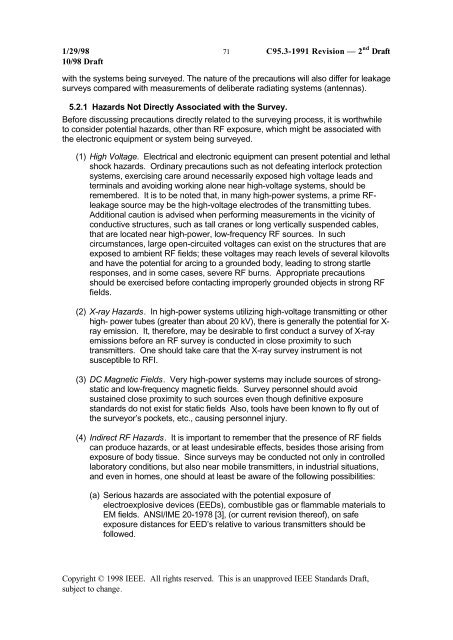DRAFT Recommended Practice for Measurements and ...
DRAFT Recommended Practice for Measurements and ...
DRAFT Recommended Practice for Measurements and ...
Create successful ePaper yourself
Turn your PDF publications into a flip-book with our unique Google optimized e-Paper software.
1/29/98 71 C95.3-1991 Revision — 2 nd Draft<br />
10/98 Draft<br />
with the systems being surveyed. The nature of the precautions will also differ <strong>for</strong> leakage<br />
surveys compared with measurements of deliberate radiating systems (antennas).<br />
5.2.1 Hazards Not Directly Associated with the Survey.<br />
Be<strong>for</strong>e discussing precautions directly related to the surveying process, it is worthwhile<br />
to consider potential hazards, other than RF exposure, which might be associated with<br />
the electronic equipment or system being surveyed.<br />
(1) High Voltage. Electrical <strong>and</strong> electronic equipment can present potential <strong>and</strong> lethal<br />
shock hazards. Ordinary precautions such as not defeating interlock protection<br />
systems, exercising care around necessarily exposed high voltage leads <strong>and</strong><br />
terminals <strong>and</strong> avoiding working alone near high-voltage systems, should be<br />
remembered. It is to be noted that, in many high-power systems, a prime RFleakage<br />
source may be the high-voltage electrodes of the transmitting tubes.<br />
Additional caution is advised when per<strong>for</strong>ming measurements in the vicinity of<br />
conductive structures, such as tall cranes or long vertically suspended cables,<br />
that are located near high-power, low-frequency RF sources. In such<br />
circumstances, large open-circuited voltages can exist on the structures that are<br />
exposed to ambient RF fields; these voltages may reach levels of several kilovolts<br />
<strong>and</strong> have the potential <strong>for</strong> arcing to a grounded body, leading to strong startle<br />
responses, <strong>and</strong> in some cases, severe RF burns. Appropriate precautions<br />
should be exercised be<strong>for</strong>e contacting improperly grounded objects in strong RF<br />
fields.<br />
(2) X-ray Hazards. In high-power systems utilizing high-voltage transmitting or other<br />
high- power tubes (greater than about 20 kV), there is generally the potential <strong>for</strong> X-<br />
ray emission. It, there<strong>for</strong>e, may be desirable to first conduct a survey of X-ray<br />
emissions be<strong>for</strong>e an RF survey is conducted in close proximity to such<br />
transmitters. One should take care that the X-ray survey instrument is not<br />
susceptible to RFI.<br />
(3) DC Magnetic Fields. Very high-power systems may include sources of strongstatic<br />
<strong>and</strong> low-frequency magnetic fields. Survey personnel should avoid<br />
sustained close proximity to such sources even though definitive exposure<br />
st<strong>and</strong>ards do not exist <strong>for</strong> static fields Also, tools have been known to fly out of<br />
the surveyor’s pockets, etc., causing personnel injury.<br />
(4) Indirect RF Hazards. It is important to remember that the presence of RF fields<br />
can produce hazards, or at least undesirable effects, besides those arising from<br />
exposure of body tissue. Since surveys may be conducted not only in controlled<br />
laboratory conditions, but also near mobile transmitters, in industrial situations,<br />
<strong>and</strong> even in homes, one should at least be aware of the following possibilities:<br />
(a) Serious hazards are associated with the potential exposure of<br />
electroexplosive devices (EEDs), combustible gas or flammable materials to<br />
EM fields. ANSI/IME 20-1978 [3], (or current revision thereof), on safe<br />
exposure distances <strong>for</strong> EED’s relative to various transmitters should be<br />
followed.<br />
Copyright © 1998 IEEE. All rights reserved. This is an unapproved IEEE St<strong>and</strong>ards Draft,<br />
subject to change.
















